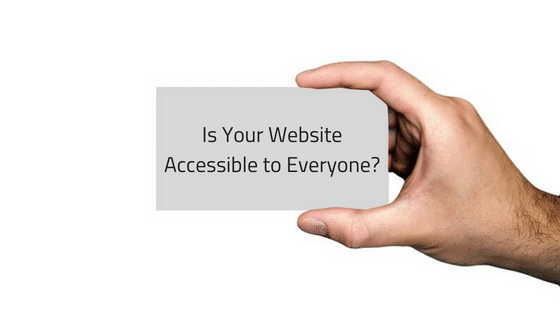Website accessibility is a hot topic following new 2018 legislation that expanded ADA compliance requirements to online resources. Now businesses really need to be asking themselves if their sites are really as accessible as they once believed. Fortunately, the published WCAG 2.0 guidelines are paving the way to easy accessibility for all websites. Here’s what you need to consider:
Understanding Disabilities of Different Types
Before you can answer whether or not your site is accessible, you first have to define what accessibility means. According to the ADA and the WCAG 2.0 guidelines, accessibility means that your site is Perceivable, Operable, Understandable and Robust. However, those words don’t mean much on their own. Most often when we think about accessibility issues, we think about wheelchair usage and limited physical mobility. On the web, accessibility has to do with a different range of disabilities. For instance, color blindness is a disability that affects millions of people when using the web. People with severe color blindness use specialized programs to help convert all websites into high contrast color schemes for easier reading. This is probably something that you haven’t ever considered in terms of accessibility, but your web design team must be cognizant of it. If the website is not properly formatted, it cannot be converted to the appropriate color scheme and will be considered inaccessible under the new rules.
Other types of disabilities that affect website users include auditory processing issues which make it difficult to hear videos or recordings and other disabilities which require accessibility technologies like screen readers to read out the content of a page to the user. However, even physical disabilities need to be considered. Some users with limited mobility rely solely on keyboards to navigate through websites. For your site to be accessible, users must be able to move freely about the site with a keyboard and navigate between pages logically.
Behind the Scenes Accessibility Issues
All of the above considerations have to do with how users interact with your site and their user experience. However, accessibility issues reach even deeper into the guts of your site. For instance, alt tags on images play an important role in helping accessibility readers and software through your site. Proper HTML tagging is imperative in translating your site into a format that a screen reader can use. Any downloads or links on your site must be properly formatted as well. Even your forms and submission boxes need to have certain accessibility features in place to meet the ADA standards.
This is where accessibility audits really come in handy. For designers, it is difficult to think about how every bracket and tag might impact an end-user who is accessing the site from a non-traditional device. However, auditing software makes it simple to scan your site’s coding, detect errors that might not be a factor on a regular desktop or mobile device, and send you an alert. Then these issues can be easily detected and remedied before they become a formal complaint from a customer. Scanning tools are readily available to help companies meet compliance standards and provide customers with a great user experience regardless of disability.
Hopefully, now you can see why ADA compliance is important, and understand the wide range of issues that affect ADA websites. For those who have never considered the impact of website design for people with disabilities, now is the time to start reading up on different accessibility issues and how you can act to make your content widely available. Understanding all of the different assistive technologies on the market can also help ensure that your site is ADA friendly.















